Data flow analysis of transactional processes
a transactional process and data flow technology, applied in the field of computer software compilers, can solve the problems of large memory resources occupied by storage of multiple data objects, human error in the selection of data objects to be deleted, and complexity of software code, so as to avoid burdening every service implementation
- Summary
- Abstract
- Description
- Claims
- Application Information
AI Technical Summary
Benefits of technology
Problems solved by technology
Method used
Image
Examples
Embodiment Construction
Overview
[0023]A XLANG / s compilation method is provided that parses XLANG / s code into one or more flowgraphs representative of the logical operation of the code. The method identifies a data object such as, for example, a variable in the flowgraph and tracks the operations that are performed on such data object. The method also places a creation point for such an object at an optimal location within XLANG / s code as late as possible prior to the object's first use. In addition, the method places a destruction point for such data object as early as possible after such object's last use. The method further places a lock point for a shared data object at an optimal location: at a location that avoids deadlocked code, while being as close prior to the first use of such object as possible.
Exemplary Computing Environment
[0024]FIG. 1 illustrates an example of a suitable computing system environment 100 in which the invention may be implemented. The computing system environment 100 is only on...
PUM
 Login to View More
Login to View More Abstract
Description
Claims
Application Information
 Login to View More
Login to View More - R&D
- Intellectual Property
- Life Sciences
- Materials
- Tech Scout
- Unparalleled Data Quality
- Higher Quality Content
- 60% Fewer Hallucinations
Browse by: Latest US Patents, China's latest patents, Technical Efficacy Thesaurus, Application Domain, Technology Topic, Popular Technical Reports.
© 2025 PatSnap. All rights reserved.Legal|Privacy policy|Modern Slavery Act Transparency Statement|Sitemap|About US| Contact US: help@patsnap.com



